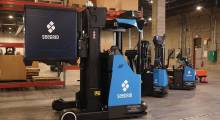David Krebs ,VDC Research
Title
Executive vice president of enterprise mobility, connected devices and AutoID
Location
Framingham, Mass.
Experience
20 years at VDC
Primary Focus
Researching how technology is enabling a more connected and engaged workforce.
Modern: This is a question we’ve asked in the past, but we continue to hear about mobility in our personal and professional lives. What does mobility mean in today’s supply chain world?
Krebs: When we look at the supply chain, the average warehouse space is growing; the level of automation in these environments is increasing; and yet we’re also seeing larger workforces. To make sure those workforces are as agile as possible, mobility is a piece of that.
Modern: What are the primary drivers of mobility in warehousing and transportation today?
Krebs: It’s about speed. With that comes getting orders shipped faster, improving your labor and storage utilization, and reducing the cost of errors. You can think of mobility as the gateway to the information that you need to direct your workforce and also acts as the entry point for checking off tasks. It orchestrates all of those activities.
Modern: That being the case, what’s different? Or, what’s changing?
Krebs: The mobile device still looks and operates much as it has in the past. So, the biggest change is the eventual migration to Android. For proof-of-delivery services it’s an Android world. At the same time, the warehouse and DC are still using old school terminal emulation strategies. Eventually, they’ll be forced to shift, but not yet. As some device manufacturers deliver devices that leverage Android, we’re seeing more touch-centric user interfaces that get away from the keyboard, although in truth, the keyboard is dying a slow death.
Modern: Are we seeing new competitors? Or, are the legacy providers still the primary players?
Krebs: A drastic shift creates opportunities for new competitors. As an example, mobile robots are leveraging vision technology, so when I look at the automatic data capture side of the business, I think the manufacturers in the strongest positions are the ones who know vision technologies the best.
Modern: What’s happening with wearables?
Krebs: Wearables are a way to hands-free mobility. As the price comes down, we’re seeing a greater adoption of wrist-mounted computers and ring scanners, for instance. Smart glasses, in my view, are still an emerging technology. Ultimately, labor is the single largest expense in the warehouse, and Amazon just announced a $15 an hour base. At some point, increasing costs will lead to the introduction of more automation and data collection.
Modern: Are you watching the augmented and virtual reality spaces?
Krebs: It’s emerging, but we are seeing some vision-based picking solutions as an alternative to voice-based picking solutions. They may leverage augmented reality to identify products for that process. But, right now the technology has cost-to-performance barriers to overcome. Outside of the design of a new warehouse or DC, or maybe training, virtual reality doesn’t really have a place to play. Augmented reality is interesting, but I think we’re getting a little too excited about a technology that I’m not sure provides that much of a benefit over conventional solutions.
Modern: What are you advising the user community?
Krebs: We’re advising two things. One is to keep an open mind in terms of these new technologies and how they might apply to your businesses and operations. The benchmarks you use to rate your operations are no longer valid at times. At the same time, technology for technology’s sake has never helped anyone. In these environments, you want a technology you can support and make sure it’s sustainable. But don’t stick your head in the sand. Changes are afoot. If you don’t provide the level of performance that meets the new normal, someone else will.
Article topics








